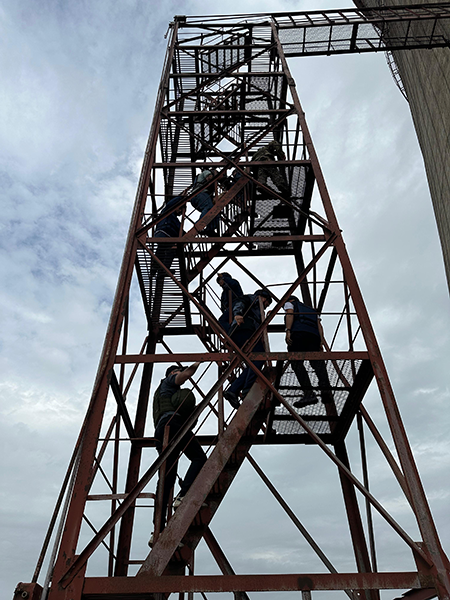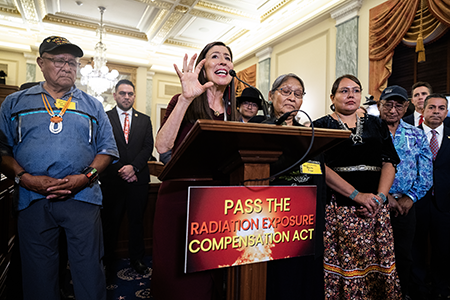"I find hope in the work of long-established groups such as the Arms Control Association...[and] I find hope in younger anti-nuclear activists and the movement around the world to formally ban the bomb."
The situation at Ukraine’s Zaporizhzhia Nuclear Power Plant “remains precarious” due to regular explosions and drone attacks, Rafael Mariano Grossi said after the visit.
October 2024
By Doniyor Mutalov
The situation at Ukraine’s Zaporizhzhia Nuclear Power Plant “remains precarious” due to “regular explosions, drone attacks, and repeated interruptions of power supply” that heighten the risk of a nuclear accident, according to the head of the International Atomic Energy Agency (IAEA).

IAEA Director-General Rafael Mariano Grossi shared his continuing concerns in a statement Sept. 16 following a recent visit to the power plant, which has been occupied by Russian military forces since shortly after Russia’s full-scale invasion of Ukraine in February 2022.
“Preventing a nuclear accident during this terrible war is vital, and attacking a nuclear power plant is unacceptable, regardless of where it is located,” he said.
In comments to the IAEA Board of Governors on Sept. 9, Grossi disclosed that, “in line with the agency’s advice, it is understood that no reactor will be restarted as long as the conflict continues to jeopardize the nuclear safety and security of the plant.” The Wall Street Journal reported in April that Russia wanted to restart at least one reactor at the power plant.
During his latest visit to the Zaporizhzhia facility, on Sept. 4, Grossi inspected the remains of a fire that ignited on Aug. 11 inside one of the plant’s cooling towers. The IAEA, in an Aug. 13 statement, rejected claims that a drone struck the towers and determined that no “foreign objects or materials were visible.” Because the facility is no longer operational, the cooling towers are not needed to cool the plant’s six reactors, and the fire did not pose any immediate threat to nuclear safety, the agency said. The fire-damaged cooling tower may have to be demolished, it said.
In a statement Sept. 5, the IAEA also highlighted Grossi’s visit to the water-pumping stations at the Zaporizhzhia plant and the availability of cooling water in the facility’s cooling pond, which has dropped by two meters since the destruction of the nearby Kakhovka dam in June 2023. The Kakhovka reservoir previously was a source of cooling water for the reactors, but since 2023, newly dug groundwater wells have been used to provide cooling water.
The plant temporarily lost connection on Aug. 23 to its only backup power line, the 330-kilovolt Ferosplavna line, leaving the facility “precariously reliant on a single power source,” the IAEA said.
Before the conflict erupted, the Zaporizhzhia plant had four 750-kilovolt and six 330-kilovolt powerlines. Currently, only the 750-kilovolt Dniprovska and 330-kilovolt Ferosplavna power lines are still connected to the plant.
On Aug. 8, Grossi stressed that “[t]he off-site power supply to the [plant] remains vulnerable, and any threat to the operability of the last two power lines is extremely concerning.”
Indian Defense Minister Rajnath Singh said the new submarine, INS Arighaat, would “help in establishing strategic balance” in the region.
October 2024
By Libby Flatoff
The Indian Navy commissioned a second indigenously designed ballistic missile submarine, the INS Arighaat, which Defense Minister Rajnath Singh said would “help in establishing strategic balance” in the region.

The commissioning ceremony and Singh’s remarks took place Aug. 29 at the Visakhapatnam Naval Yard, the headquarters of India’s Eastern Naval Command on the Bay of Bengal, according to a same-day press release from the Indian Defense Ministry.
The Arighaat and its predecessor, the INS Arihant, each will have up to four K-4 missiles having an expected range of 3,500 kilometers. (See ACT, March 2020.) Currently, they are equipped with an older submarine-launched ballistic missile (SLBM), the K-15, which has a range of 750 kilometers. (See ACT, December 2022.) Within the submarine, each SLBM launch tube can hold three K-15 missiles or one K-4 missile. The K-4 missiles are expected to be deployed in 2025, according to the Federation of American Scientists.
In December 2023, India conducted two successful underwater tests of the K-4 missiles within six days. After these tests, a source told the Times of India that “the K-4 is now virtually ready for its serial production to kick off. The two tests have demonstrated its capability to emerge straight from underwater and undertake its parabolic trajectory.”
China, France, Russia, the United Kingdom, and the United States have SLBMs with a range of more than 5,000 kilometers. The K-4 missiles, once equipped, will narrow the capability gap between India and other nuclear-armed states. “Although India’s sea-based nuclear deterrent remains in relative infancy, the country clearly has an ambition to field a sophisticated naval nuclear force with ballistic missile submarines at its core,” Matt Korda of the Federation of American Scientists, told CNN on Sept. 14.
This year, India accomplished several successful tests to modernize its arsenal, including one involving the Agni-5 missile, the country’s first domestically produced missile capable of carrying multiple independently targeted warheads, the Agni-5 missile, which has independent targeting capability. (See ACT, April 2024.)
October 2024
By Frank N. von Hippel
Matthew Costlow describes protections against unauthorized launch.
That was not the subject of my article.
My article focused on the danger of authorized but mistaken launch due to the less than 10 minutes that the U.S. intercontinental ballistic missile (ICBM) launch-on-warning posture allows the president to make the launch decision, combined with the pressure that Strategic Command would put on a president to launch if it were convinced that the early-warning system had detected an actual enemy attack.1 For a sense of the challenges of such a situation, see the partially declassified documents released by the National Security Archive earlier this year relating to what was meant to have been a presidential training exercise in the launch-on-warning decision-making process, in October 1977, perhaps the only one that has ever been conducted.2
The possibility of being put in this situation has terrified presidents back to Ronald Reagan.3 The Pentagon insists on a launch-on-warning posture, but not because of the deterrence benefits that Costlow claims. If 1,000 warheads on ballistic missile submarines at sea are an insufficient deterrent, an ICBM launch-on-warning policy will not change that situation.
But every U.S. missile warhead has an assigned target, and Strategic Command has made covering all those targets, no matter how minor, a higher priority than avoiding the danger of a mistaken launch.4 The imperative of target coverage has prevailed over that of protecting civilization.
After decades of failed efforts to persuade the Pentagon to change its priorities, some of us have concluded that the only way out of this impasse is to get rid of the ICBMs. Historically, Congress has been most willing to cancel counterproductive government programs when those programs have incurred huge cost overruns and indefinitely growing delays. The U.S. ICBM replacement program has developed this syndrome and therefore is providing a rare opportunity to reduce the danger of accidental nuclear war.
ENDNOTES
1. B.G. Blair, “Loose Cannons: The President and U.S. Nuclear Posture,” Bulletin of the Atomic Scientists, Vol. 76, No. 1 (2020): p. 12-26; Jonathan Schell, The Gift of Time (New York: Henry Holt, 1998), p. 194 (interview of General George Lee Butler, commander in chief, Strategic Command) (hereinafter Butler interview).
2. “Ivory Item: Carter First U.S. President to Participate in Nuclear Drill,” National Security Archive, May 31, 2024, https://nsarchive.gwu.edu/briefing-book/nuclear-vault/2024-05-31/ivory-item-carter-first-us-president-participate-nuclear.
Frank N. von Hippel is senior research physicist and professor of public and international affairs emeritus in the Program on Science and Global Security at Princeton University.
Nearly 80 years have passed since the atomic bomb created by J. Robert Oppenheimer and the Manhattan Project was detonated secretly in central New Mexico. The Trinity explosion not only ushered in the nuclear age and triggered the Cold War arms race, it also spread deadly radioactive fallout across dozens of states and led to increased rates of cancer and other radiation-related illnesses for millions of American downwinders.
October 2024
By Daryl G. Kimball
Nearly 80 years have passed since the atomic bomb created by J. Robert Oppenheimer and the Manhattan Project was detonated secretly in central New Mexico. The Trinity explosion not only ushered in the nuclear age and triggered the Cold War arms race, it also spread deadly radioactive fallout across dozens of states and led to increased rates of cancer and other radiation-related illnesses for millions of American downwinders.

The United States went on to test 928 nuclear bombs at the Nevada Test Site outside Las Vegas, 100 of which were above ground. Most of these blasts were far more powerful than the bombs that destroyed Hiroshima and Nagasaki.
In addition, hundreds of thousands of uranium miners, workers who manufactured weapons, and residents of communities in dozens of states were poisoned by the wastes produced by the Manhattan Project and the massive weapons complex that was part of the nuclear arms buildup that followed World War II.
Today, thousands of Americans still live with the tragic consequences of Oppenheimer’s bomb and the orgy of nuclear testing and weapons production that followed. For them, the Cold War has never really ended.
Unfortunately, the leadership in the House of Representatives has blocked legislation that would reauthorize and expand a program under the 1990 Radiation Exposure Compensation Act (RECA) to assist those harmed by Cold War-era uranium mining, nuclear weapons production, and testing.
Before adjourning this year, House Speaker Mike Johnson (R-La.) and Congress have an opportunity and a moral obligation to approve updated legislation that would begin to address the shortcomings of the original RECA program, which excluded far too many victims of the U.S. testing program.
The existing program provides limited compensation only to those who lived in 22 largely rural counties of Arizona, Nevada, and Utah between 1951 and 1958 and during the summer of 1962 who developed leukemia or one of 17 other kinds of cancer. It also covers uranium miners from 1942 through 1971 who can document a subsequent diagnosis of a specified compensable disease.
The new bill, the Radiation Exposure Compensation Reauthorization Act, introduced by Sens. Ben Ray Lujan (D-N.M.), Mike Crapo (R-Idaho), and Josh Hawley (R-Mo.), was approved by the Senate 69-30. It would reauthorize the RECA program for six years and expand partial compensation to communities that have been excluded. If considered by the House, the bill very likely would win passage. President Joe Biden has said he would sign it.
The RECA program expired in June. Further dithering would be a dereliction of duty. Johnson reportedly has complained that the Senate bill would cost tens of billions of dollars and compensate people who were not affected by nuclear testing and Manhattan Project-era weapons production.
He is wrong on both counts. As of February 2024, the RECA program had paid $2.6 billion to more than 41,000 claimants since the program began in 1990. Experts say that if the program were reauthorized for six years and expanded, it is highly unlikely that there would be more than $5 billion in additional eligible claims, if that much.
In any case, the additional money spent on an expanded RECA program would amount to a small fraction of the estimated $756 billion that the United States expects to pay for modernizing its massive nuclear arsenal over the coming decade.
Cost should not be an issue. But if House leaders truly are concerned about that factor, they could work with RECA proponents in both chambers to set a cap on the total amount that could be paid for compensation claims.
Moreover, numerous health studies since 1990 have shown that fallout from past nuclear tests did not stop at the county or state lines recognized under the original RECA program. For instance, northern Utah, the most populated area of the state, never has been included in the program.
Incredibly, the many downwinders affected by the Trinity test in New Mexico, who are mostly Hispanics and Native Americans, never were warned about the fallout, never were acknowledged as victims, and never were included in the RECA program. Uranium miners working after 1971 and communities in the Navajo Nation and other western states whose land and water is still poisoned by uranium mining waste have been ignored as well. So have residents whose homes and schools are contaminated by radioactive waste from Manhattan Project-era sites around St. Louis and other former weapons-related sites across the country, including my hometown of Oxford, Ohio.
Under the Senate bill, the RECA program would be extended to eligible downwinders in seven western states and Guam. It also would add additional uranium workers and residents in Alaska, Kentucky, Missouri, and Tennessee who are living in or near areas contaminated by the effects of nuclear weapons production.
Americans who have been endangered by their government’s nuclear weapons production and testing without their knowledge or consent deserve justice and accountability.
A version of this op-ed, co-authored with Mary Dickson, first appeared in The Hill in June.
